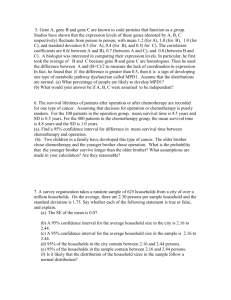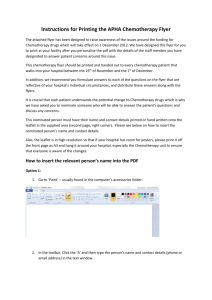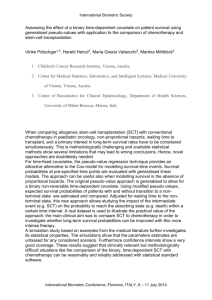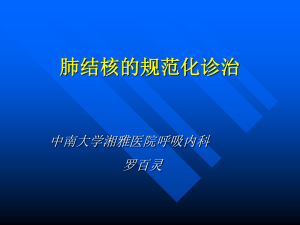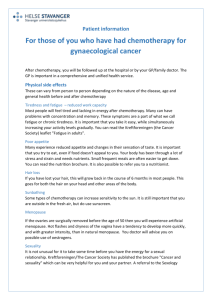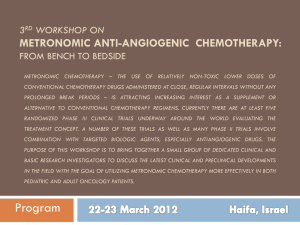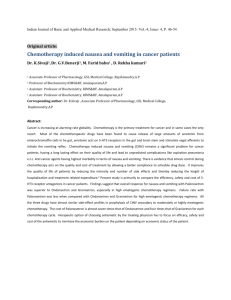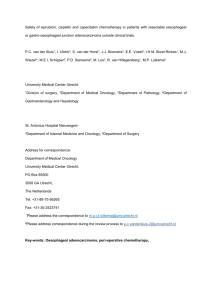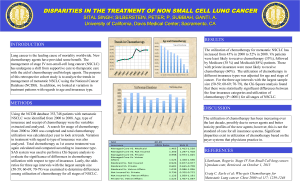Palliative Chemotherapy
advertisement
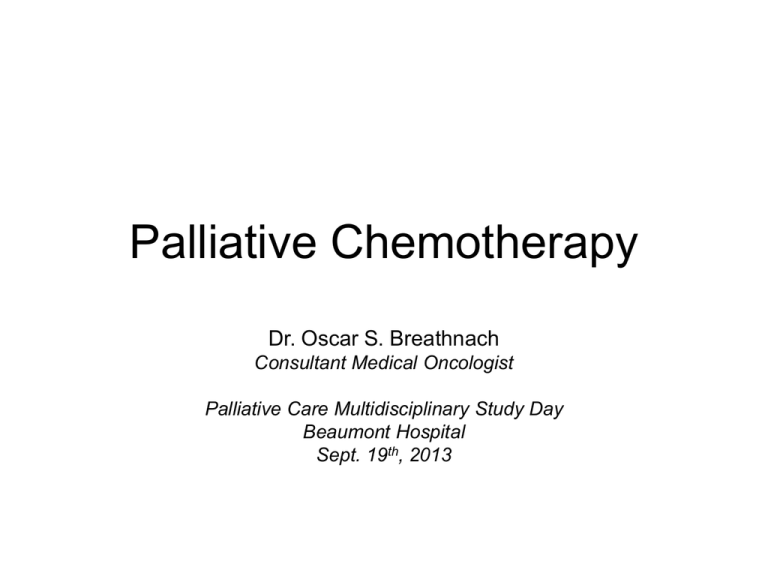
Palliative Chemotherapy Dr. Oscar S. Breathnach Consultant Medical Oncologist Palliative Care Multidisciplinary Study Day Beaumont Hospital Sept. 19th, 2013 You have been diagnosed with ADVANCED CANCER CANCER PATIENT [ mind-body-spirit ] Cultural Environment FAMILY / FRIENDS OUTCOME MEDIA / INTERNET Belief Systems Life Events MEDICAL / NURSING STAFF Cancer, an age-related event in a population with Less Births / Prolonged Survival When cure is not a reality • • • • • • • • Suspecting the cancer Suspicions confirmed Staging the cancer Advanced stage Opinion re chemotherapy Personal and family reactions Hope vs reality Chemotherapy Objectives PERSON: • Live longer • Quality of Life • Dignity STATE: • Cost-effectiveness • Standards of care MEDICAL STAFF: • Maintain quality of life • Minimise toxicity • Prolong survival • Progression-free survival • Minimise diseaserelated toxicity • Balance between all the various factors Palliative Chemotherapy • Other patients / families (the waiting room) • Anti-cancer agents • Support personnel: – oncologists, nurses, physios, OTs, dieticians, social workers, psycho-oncology, palliative care team, health care assistants, ward clerks, catering staff, cleaners, etc • • • • The Hospital building The Internet’s message of hope / options The Myths History / transmitted memories 3 Lives -:- 3 Pathways • Relatively asymptomatic • Symptomatic, but reversible • Profoundly symptomatic, non-reversible Considerations re Treatment • • • • Performance Status Range of agents Therapeutic target Measuring benefit – Symptoms – Radiology – Function • When to break / stop Survival curve percentiles and their corresponding scenarios. Kiely B E et al. JCO 2011;29:456-463 ©2011 by American Society of Clinical Oncology Selected Toxicities Erlotinib and Docetaxel (indirect retrospective contrast) 80 70 60 50 40 30 20 10 0 i on Infec t ue Fatig oea Diar rh Stom atitis ing Vom it Naus e a Erlotinib Placebo (BR21) Docetaxel Emerging Targets: NSCLC, adenoca. Metastatic: NSCLC, 1st line • Histology / Molecular profile – EML4-ALK mutation – EGFR mutation – K-ras Study Agents LUX LUNG 3 Cisplat-Pem Afatinib IPASS Carbo-Pac Gefitinib EURTAC Cis/Doc or Gem Erlotinib (7% of adenocarinoma) (17% of adenocarcinoma) (22% of adenocarcinoma) RR 22% 56% 41% 71% 15% 58% PFS (mos) 6.9 11.1 (13.6) 5.5 9.0 5.2 9.7 Lux Lung 3: common mutations Toxicity Profile Afatinib vs Cis/Pem Grade 3/4 Toxicity (%) Grade 3/4 Toxicity (%) Diarrhoea 14.4 0 Rash/acne 16.2 0 8.7 0.9 11.4 0 Nausea 0.9 3.6 Fatigue 1.3 12.6 Stomatitis/mucositis Paronychia Lux Lung 3 Ms. A.A • Small cell • Lives with partner, children abroad • Nervous • Extreme dyspnoea • Haemoptysis Nov. 13th, 2012 Pre- and Post 4 cycles of chemotherapy Post sequential chest radiation 8 months post diagnosis 5 months post completion of chemotherapy Ms. M.C. • Breast lesion x 4yrs • Single; no children • Bleeding chest wall; increasing left arm pain, with decreasing sensation • Deliberated over radiation and chemotherapy Pre-Treatment Progressive disease: Dx date +5 months Further chemotherapy: Dx date +12 mths Considerations • • • • • • • • The Person The Realistic outcomes Realistic optimism The person’s objectives Focus on Quality / Prolongation of life When not to treat Beyond treatment Those remaining Choose Wisely


